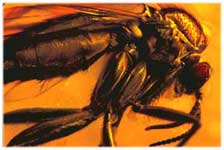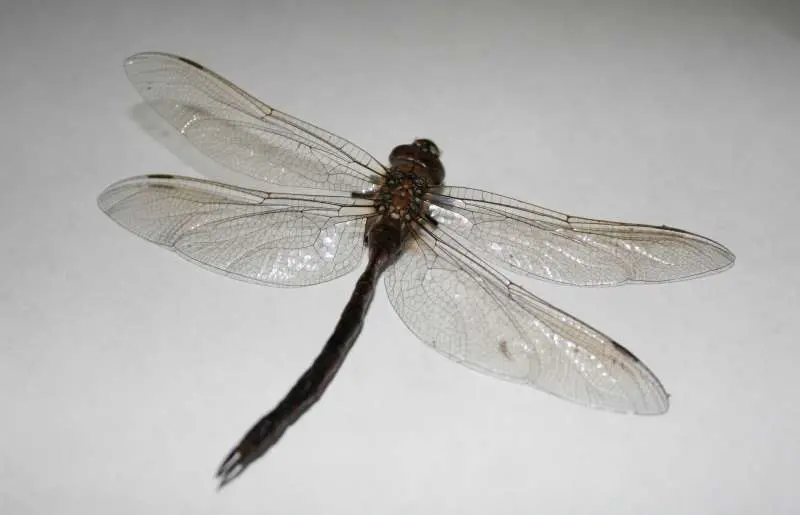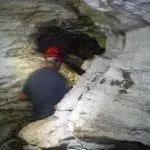Some years ago, while out hunting for small critters to photograph with my bug-photographing device, I had the privilege of observing an unforgettable insect performance. I was slowly crawling through a patch of waist-high weeds, when I scared up an attractive, bluish-coloured damselfly, about 25 millimetres (one inch) long. (Damselflies look much like dragonflies except that when at rest, the damsel’s wings are held straight back along the body rather than outward.)
 Gnat in amber. Courtesy Mark Meyer/3 Dot Studio . |
For several minutes I stalked this little creature as it fluttered from plant to plant. My plan was to get close enough for a good picture. Eventually, after the damsel had threaded its way through tangled stems, leaves and flowers, it passed within a metre (3 feet) of a small spider’s web that had a tiny object near its centre. Then something very unusual happened.
The damselfly hovered about 30 centimetres (one foot) in front of the web, seeming to study the spider’s lair. Then, after a few seconds, it ever so deliberately moved forward until … wham! It was caught, head first, right where the object was in the web! ‘What a picture this will make’, I exclaimed to myself as I thought about how clumsy this little fellow was to do such a thing.
To my surprise, however, even though it looked like its head was hopelessly stuck to the sticky silk, it kept flying. The damsel hovered in place while tugging and tugging on the web until … ‘pop’, it broke free—taking with it the object that was in the web. Soon I discovered that this little acrobatic thief had stolen the spider’s meal out of the spider’s web, without getting snagged itself!
Wonderful design
It fluttered to a nearby plant, landed and began to feast. Hastily, I took a picture to document what the damselfly had stolen from the poor spider. It turned out to be a gnat, about the size of a pinhead. What amazes me is that the damselfly could spot such a minute and immobilized morsel from so far away, let alone snatch it from a spider’s trap without getting caught itself. Good thing the spider wasn’t home, or it may have been the next course in this hungry fellow’s meal!
Our fantastic designer God has provided an ecosystem with innumerable examples of incredibly adept organisms able to do remarkable things. I believe that at the creation of the universe, thousands of years ago, the Lord Jesus knew that on one warm summer day, while on my knees in a bunch of weeds, I would be reminded of his personal interest in me as I watched a pretty little damselfly put on an entertaining show.
 Damselfly drawing (courtesy Corel Draw). |
You and your children can develop an appreciation for the creative skill of the Lord by going on a tiny creature safari, with magnifying glass in hand, and watching for whatever surprises are awaiting you. An adventure even as unique as mine need not take you far from home. It can be as close as your own backyard.
So next time you see a ladybug or other small creature, watch where it goes and what it does over a period of time. You may be impressed at how much you will learn. Then don’t forget to praise God for the interesting world He has made!
Try it
- Take a butterfly net and drag it through the grass, while running about in the yard. In this way you will scare up and catch a large variety of small organisms that spend their whole lives in the grass without your ever knowing it.
- After you have ‘swept the yard’, dump the whole lot into an empty aquarium or a plastic-covered box to study what you have. You will be surprised at what is there.
- Now that you have an idea about what to look for, try to find the organisms without catching them, then intently watch as they go about their business. (If you do a lot of observing in your yard, don’t be intimidated by the inquisitive looks from the neighbours who may be watching you watch the bugs! Instead, use the opportunity to witness to them about our wonderful Creator-God.)
Tom Wagner is a science teacher in Indiana USA. He is a keen photographer whose articles and photographs appear frequently in Creation magazine.






